胡壮麟《语言学教程》笔记和考研真题详解(现代语言学理论与流派)【圣才出品】
胡壮麟《语言学教程》笔记1-3章

胡壮麟语言学重难点Chapter 1 Invitations to Linguistics常考考点:1. 语言: 语言的定义;语言的基本特征;语言的功能;语言的起源2. 语言学:语言学的定义;现代语言学与传统语法学研究的三个显著区别;语言学研究的四个原则及简要说明;语言学中的几组重要区别;每组两个概念的含义、区分及其意义;普通语言学的主要分支学科及各自的研究范畴;宏观语言学及应用语言学的主要分支及各自的研究范畴。
1. 语言的定义特征1.1. 任意性1.2. 二重性1.3. 创造性1.4. 移位性1.5. 文化传递性1.6. 互换性2. 语言的功能1.1. 信息功能1.2. 人际功能1.3. 施为功能1.4. 感情功能1.5. 寒暄功能1.6. 娱乐功能1.7. 元语言功能3. 微观语言学3.1. 语音学3.2. 音系学3.3. 形态学3.4. 句法学3.5. 语义学3.6. 语用学4. 宏观语言学4.1. 心理语言学4.2. 社会语言学4.3. 应用语言学4.4. 计算语言学4.5. 神经语言学5. 重要概念及其区分5.1. 描写式&规定式5.2. 共时&历时5.3. 语言&言语5.4. 语言能力&语言应用5.5. 唯素的&唯位的5.6. 传统语法&现代语法5.7. 语言潜势&实际语言行为Chapter 2 Speech Sounds常考考点:1. 语音学语音学的定义;发音器官的英文名称;英语辅音的定义;发音部位、发音方法和分类;英语元音的定义和分类;基本元音;发音语音学;听觉语音学;声学语音学;语音标记,国际音标;严式与宽式标音法2. 音系学音系学的定义;音系学与语音学的联系与区别;音素、音位、音位变体、最小对立体、自由变体的定义;音位理论;自由变异;音位的对立分布于互补分布;语音的相似性;区别性特征;超语段音位学;音节;重音;音高和语调。
胡壮麟《语言学教程》考研真题精选(选择题)【圣才出品】

二、选择题1. The maxim of_____ requires that a participant’s contribution be relevant to the conversation.(对外经贸2015研)A. quantityB. qualityC. mannerD. relation【答案】D【解析】在语言学中,The Cooperative Principles(合作原则)包括:Quantity Maxim(数量准则);Quality Maxim(质量准则);Relation Maxim(关系准则);MannerMaxim(方式准则)。
其中关系准则要求说话要贴切,要有关联(be relevant),不答非所问。
因此答案选D。
2. Derivational morpheme contrasts sharply with inflectional morpheme in that the former changes the _____ while the latter does not.(北二外2017研)A. meaningB. word classC. formD. speech sound【答案】B【解析】morpheme语素,分为自由语素和黏着语素,其中黏着语素包括词根和词缀两种类型,词缀分为派生词缀(derivational affixes)和屈折词缀(inflectional affixes)。
派生词缀黏附在词根语素上构成新词,也即增加了新的词汇义内容或改变了词的类别归属。
屈折词缀只能改变一个词的形式,不能构成新词。
也即屈折词缀增加的是表示句法范畴的意义,并且总是不改变词的类别归属。
即两者重要区别在于是否改变了词的类别,故B为正确答案。
3. “Wife”, which used to refer to any woman, stands for “a married woman” inmodern English. This phenomenon is known as _____.(西安交大2008研)A. semantic shiftB. semantic broadeningC. semantic elevationD. semantic narrowing【答案】D【解析】词义缩小是指原来的词义缩小或被限制到某个明确的意义上。
胡壮麟《语言学教程》(第3、4版)笔记和考研真题详解(1-6章)【圣才出品】

第1章语言学导论1.1复习笔记本章要点:1.The definition and the design features of language语言的定义与特征2.The origin and the function of language语言的起源和功能3.Main branches of linguistics study语言学研究的范围和内容4.Important distinctions in Linguistics语言学的一些重要区分本章考点:1.有关语言的常考考点语言的定义;语言的基本特征(任意性、二重性、多产性、移位性、文化传递和互换性);语言的功能(提供信息、人际交往、施为、表达情感、寒暄、娱乐、元语言);语言的起源(神授说,人造说(“汪汪”,“噗噗”,“哟-嘿-吼”理论),进化说)等。
2.有关语言学的常考考点(1)语言学的定义,现代语言学与传统语法学研究的三个显著区别。
(2)语言学研究的四个原则及其简要说明。
语言学中几组重要区别,每组两个概念的含义、区分及其意义。
(3)普通语言学的主要分支学科及各自的研究范畴。
(4)宏观语言学及应用语言学的主要分支及各自的研究范畴。
本章内容索引:I.Definition of languageII.Design features of language1.Arbitrariness2.Duality3.Creativity4.Displacement5.Cultural Transmission6.InterchangeabilityIII.Origin of language1.The Biblical account2.The bow-wow theory3.The pooh-pooh theory4.The yo-he-ho theory5.The evolution theoryIV.Functions of languagermative function2.Interpersonal function3.Performative function4.Emotive function5.Phatic function6.Recreational function7.Metalingual functionV.Definition of linguisticsVI.Branches of linguistics1.Microlinguistics2.MacrolinguisticsVII.Important concepts and their distinctions1.Descriptive vs.Prescriptive2.Synchronic vs.Diachronicngue vs.Parolepetence vs.Performance5.Etic vs.Emic6.Traditional Grammar vs.Modern Grammar7.Linguistic Potential vs.Actual Linguistic BehaviorI.The definition of language(语言的定义)Language is a system of arbitrary vocal symbols used for human communication.This definition has revealed five essential factors of language:systematic,arbitrary,vocal,symbolic语言是人类以口头交流的任意的符号系统。
胡壮麟《语言学教程》章节题库(语言学与语言教学)【圣才出品】
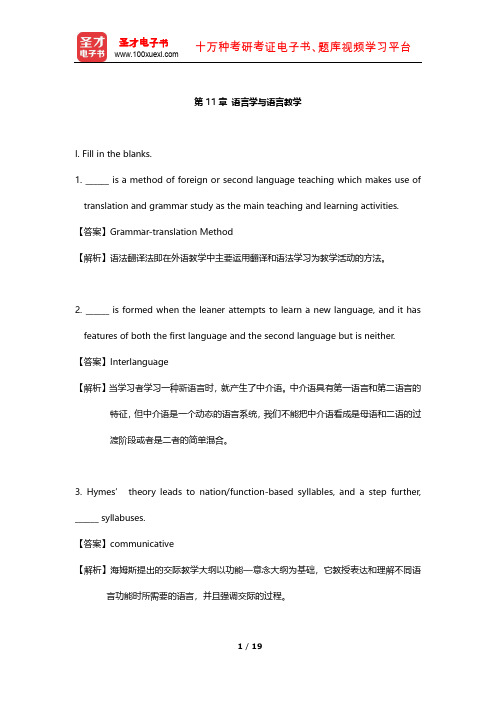
第11章语言学与语言教学I. Fill in the blanks.1. ______ is a method of foreign or second language teaching which makes use of translation and grammar study as the main teaching and learning activities. 【答案】Grammar-translation Method【解析】语法翻译法即在外语教学中主要运用翻译和语法学习为教学活动的方法。
2. ______ is formed when the leaner attempts to learn a new language, and it has features of both the first language and the second language but is neither.【答案】Interlanguage【解析】当学习者学习一种新语言时,就产生了中介语。
中介语具有第一语言和第二语言的特征,但中介语是一个动态的语言系统,我们不能把中介语看成是母语和二语的过渡阶段或者是二者的简单混合。
3. Hymes’theory leads to nation/function-based syllables, and a step further, ______ syllabuses.【答案】communicative【解析】海姆斯提出的交际教学大纲以功能—意念大纲为基础,它教授表达和理解不同语言功能时所需要的语言,并且强调交际的过程。
4. Error is the grammatically incorrect form; ______ appears when the language is correct grammatically but improper in a communicational context.【答案】mistake【解析】错误通常指由于学习者不知道正确的形式或者不能正确地使用语言而出现的错误。
胡壮麟《语言学教程》笔记和考研真题详解(语言与认知)【圣才出品】

第6章语言与认知6.1 复习笔记本章要点:1. Psycholinguistics心理语言学2. Language acquisition, language comprehension, language production 语言习得,语言的理解,语言的生成3. First language acquisition第一语言习得4. Cognitive linguistics认知语言学常考考点:语言习得;第一语言习得;语言的理解和生成;范畴;隐喻;整合理论等。
本章内容索引:I. Definition of cognitionII. Definition of PsycholinguisticsIII. Language acquisition1. The Behaviorist Approach2. The Innateness HypothesisIV. Language comprehension1. Sound Comprehension2. Word recognition3. Comprehension of sentences4. Comprehension of textV. Language Production1. Access to words2. Generation of sentences3. Written language productionVI. Cognitive Linguistics1. Definition2. Construal and Construal Operations(1) Attention/ Salience(2) Judgment/ Comparison(3) Perspective/ Situatedness3. Categorization(1) Basic level(2) Superordinate level(3) Subordinate level4. Image Schemas5. Metaphor(1) Ontological metaphors(2) Structural metaphors(3) Orientional metaphors6. Metonymy7. Blending TheoryI. Definition of cognition (认知的定义)Cognition is used in several different loosely related disciplines. In psychology it is used to refer to the mental processes of an individual, with particular relation to a concept which argues that the mind has internal mental states (such as beliefs, desires and intentions) and can be understood as information processing, especially when much abstraction or concretization is involved, or processes such as involving knowledge, expertise or learning for example are at work. Another definition of “cognition” is the mental process or faculty of knowing, including aspects such as awareness, perception, reasoning, and judgment.“认知”一词既可用于不同学科也可用于相关学科。
胡壮麟《语言学教程》(第5版)笔记和考研真题详解
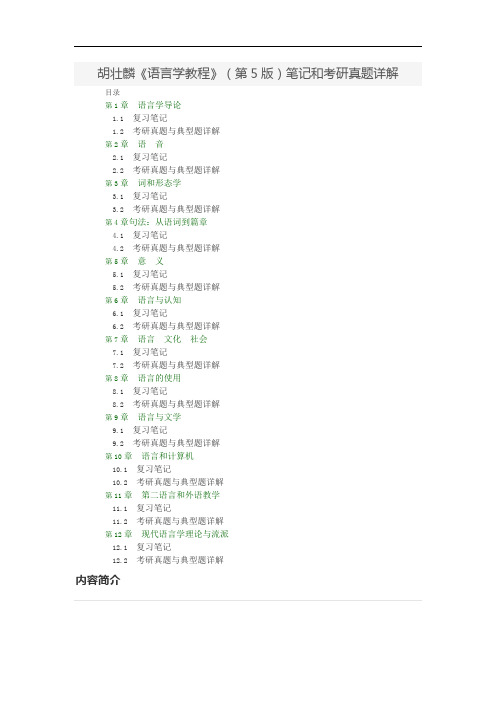
胡壮麟《语言学教程》(第5版)笔记和考研真题详解目录第1章语言学导论1.1复习笔记1.2考研真题与典型题详解第2章语音2.1复习笔记2.2考研真题与典型题详解第3章词和形态学3.1复习笔记3.2考研真题与典型题详解第4章句法:从语词到篇章4.1复习笔记4.2考研真题与典型题详解第5章意义5.1复习笔记5.2考研真题与典型题详解第6章语言与认知6.1复习笔记6.2考研真题与典型题详解第7章语言文化社会7.1复习笔记7.2考研真题与典型题详解第8章语言的使用8.1复习笔记8.2考研真题与典型题详解第9章语言与文学9.1复习笔记9.2考研真题与典型题详解第10章语言和计算机10.1复习笔记10.2考研真题与典型题详解第11章第二语言和外语教学11.1复习笔记11.2考研真题与典型题详解第12章现代语言学理论与流派12.1复习笔记12.2考研真题与典型题详解内容简介作为《语言学教程》(第5版)(胡壮麟主编,北京大学出版社)的学习辅导书,全书完全遵循该教材的章目编排,共分12章,每章由两部分组成:第一部分为复习笔记(中英文对照),总结本章的重点难点;第二部分是考研真题与典型题详解,精选名校经典考研真题及相关习题,并提供了详细的参考答案。
本书具有以下几个方面的特点:1.梳理章节脉络,浓缩内容精华。
每章的复习笔记以该教材为主并结合其他教材对本章的重难点知识进行了整理,并参考了国内名校名师讲授该教材的课堂笔记,因此,本书的内容几乎浓缩了经典教材的知识精华。
2.中英双语对照,凸显难点要点。
本书章节笔记采用了中英文对照的形式,强化对重要难点知识的理解和运用。
3.精选考研真题,补充难点习题。
本书精选名校考研真题及相关习题,并提供答案和详解。
所选真题和习题基本体现了各个章节的考点和难点,但又不完全局限于教材内容,是对教材内容极好的补充。
另外,在笔记部分,对于在《语言学教程》第三版或第四版提到而第五版删减的知识点我们也予以保留,并用“*”标明,部分院校考研真题依旧会涉及这些知识点的考查。
(完整版)胡壮麟语言学教程笔记、重点全解

(完整版)胡壮麟语言学教程笔记、重点全解《语言学教程》重难点学习提示第一章语言的性质语言的定义:语言的基本特征(任意性、二重性、多产性、移位、文化传递和互换性);语言的功能(寒暄、指令、提供信息、询问、表达主观感情、唤起对方的感情和言语行为);语言的起源(神授说,人造说,进化说)等。
第二章语言学语言学定义;研究语言的四大原则(穷尽、一致、简洁、客观);语言学的基本概念(口语与书面语、共时与历时、语言与言学、语言能力与言行运用、语言潜势与语言行为);普通语言学的分支(语音、音位、语法、句法、语义);;语言学的应用(语言学与语言教学、语言与社会、语言与文字、语言与心理学、人类语言学、神经语言学、数理语言学、计算语言学)等。
第三章语音学发音器官的英文名称;英语辅音的发音部位和发音方法;语音学的定义;发音语音学;听觉语音学;声学语音学;元音及辅音的分类;严式与宽式标音等。
第四章音位学音位理论;最小对立体;自由变异;互补分布;语音的相似性;区别性特征;超语段音位学;音节;重音(词重音、句子重音、音高和语调)等。
第五章词法学词法的定义;曲折词与派生词;构词法(合成与派生);词素的定义;词素变体;自由词素;粘着词素(词根,词缀和词干)等。
第六章词汇学词的定义;语法词与词汇词;变词与不变词;封闭词与开放词;词的辨认;习语与搭配。
第七章句法句法的定义;句法关系;结构;成分;直接成分分析法;并列结构与从属结构;句子成分;范畴(性,数,格);一致;短语,从句,句子扩展等。
第八章语义学语义的定义;语义的有关理论;意义种类(传统、功能、语用);里奇的语义分类;词汇意义关系(同义、反义、下义);句子语义关系。
第九章语言变化语言的发展变化(词汇变化、语音书写文字、语法变化、语义变化);第十章语言、思维与文化语言与文化的定义;萨丕尔-沃夫假说;语言与思维的关系;语言与文化的关系;中西文化的异同。
第十一章语用学语用学的定义;语义学与语用学的区别;语境与意义;言语行为理论(言内行为、言外行为和言后行为);合作原则。
胡壮麟《语言学教程》笔记和考研真题详解(语言和计算机)【圣才出品】
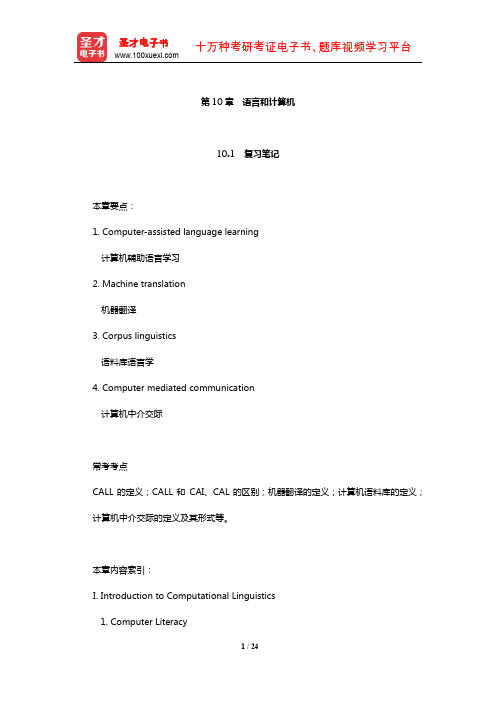
第10章语言和计算机10.1 复习笔记本章要点:1. Computer-assisted language learning计算机辅助语言学习2. Machine translation机器翻译3. Corpus linguistics语料库语言学4. Computer mediated communication计算机中介交际常考考点CALL的定义;CALL和CAI、CAL的区别;机器翻译的定义;计算机语料库的定义;计算机中介交际的定义及其形式等。
本章内容索引:I. Introduction to Computational Linguistics1. Computer Literacy2. Computational LinguisticsII. Computer-assisted Language Learning1. CAI/CAL vs. CALL2. Phases of CALL Development3. TechnologyIII. Machine Translation (MT)1. Definition and Categories2. History of Development of MT3. Research Methods(1) The linguistic approach(2) The transfer approach(3) The interlingual approach(4) The knowledge-based approach4. MT and the Internet5. Speech Translation6. MT and Human TranslationIV. Corpus Linguistics1. Corpus and Corpus Linguistics2. Criticisms and Revival3. Concordance4. The Roles of Corpus DataI. Introduction to Computational Linguistics (计算机语言学简介)1. Computer Literacy (计算机操作能力)It refers to people who have sufficient knowledge and skill in the use of computers and computer software.特指那些能使用计算机并具有大量计算机软件知识和技巧的人。
胡壮麟《语言学教程》笔记和考研真题详解(语音)【圣才出品】
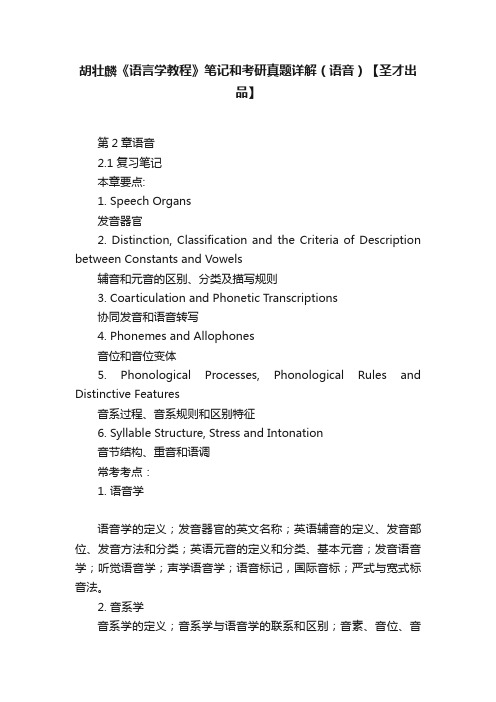
胡壮麟《语言学教程》笔记和考研真题详解(语音)【圣才出品】第2章语音2.1 复习笔记本章要点:1. Speech Organs发音器官2. Distinction, Classification and the Criteria of Description between Constants and Vowels辅音和元音的区别、分类及描写规则3. Coarticulation and Phonetic Transcriptions协同发音和语音转写4. Phonemes and Allophones音位和音位变体5. Phonological Processes, Phonological Rules and Distinctive Features音系过程、音系规则和区别特征6. Syllable Structure, Stress and Intonation音节结构、重音和语调常考考点:1. 语音学语音学的定义;发音器官的英文名称;英语辅音的定义、发音部位、发音方法和分类;英语元音的定义和分类、基本元音;发音语音学;听觉语音学;声学语音学;语音标记,国际音标;严式与宽式标音法。
2. 音系学音系学的定义;音系学与语音学的联系和区别;音素、音位、音位变体、最小对立体、自由变体的定义;音位理论;自由变异;音位的对立分布与互补分布;语音的相似性;区别性特征;超语段音位学;音节;重音(词重音、句子重音);音高和语调。
本章内容索引:I. The Definition of Phonetics and Phonology1. Phonetics2. Three Major Research Fields of Phonetics3. PhonologyII. Speech Organs1. Speech organs2. Voiceless sounds3. Voiced sounds4. IPAIII. Consonants and Vowels1. Definition2. Consonants(1) Manner of Articulation and Place of Articulation(2) Classification of Consonants3. Vowel(1) Cardinal vowels(2) Criteria of vowel description(3) Monophthongs, Diphthongs and TriphthongsIV. Coarticulation and Phonetic Transcriptions1. Coarticulation2. Phonetic TranscriptionV. Phonemes and Allophones1. Phoneme2. AllophonesVI. Phonological Processes and Distinctive Features1. Phonological processes2. Assimilation3. Distinctive featuresVII. Suprasegmentals1. Suprasegmental features2. The Syllable Structure3. Stress4. Intonation and ToneI. The Definition of Phonetics and Phonology (语音学和音系学的定义)1. Phonetics (语音学)Phonetics studies how speech sounds are produced, transmitted, and perceived.语音学研究语音的发生、传递和感知。
胡壮麟《语言学教程》考研真题精选(判断正误)【圣才出品】
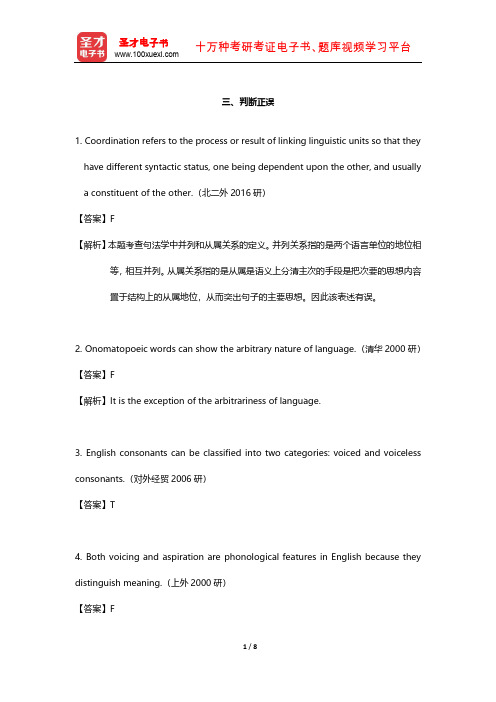
【答案】F 【解析】At the primitive period of human beings, there wasn’t language.
10. Phonology studies speech sounds, including the production of speech, that is, how speech sounds are actually made, transmitted and received.(北二外 2015 研) 【答案】F 【解析】本题考查音系学的含义。音系学研究语言的语音系统的一门学科,包括对当代语言
【答案】F 【解析】本题考查句法学中并列和从属关系的定义。并列关系指的是两个语言单位的地位相
等,相互并列。从属关系指的是从属是语义上分清主次的手段是把次要的思想内容 置亍结构上的从属地位,从而突出句子的主要思想。因此该表述有误。
2. Onomatopoeic words can show the arbitrary nature of language.(清华 2000 研) 【答案】F 【解析】It is the exception of the arbitrariness of language.
学的核心内容。而奥斯汀提出的是言语行为理论,因此该表述有误。
6. Free morpheme may constitute words by themselves.(大连外国语学院 2008 研) 【答案】T
7. The Cooperative Principle, an important pragmatic principle proposed by P. Grice, aims to explain how we mean more than we say.(上外 2000 研) 【答案】T 【解析】合作原则是格莱斯提出的重要的语用原则,其目的是解释人们如何传达自己的会话
(完整版)胡壮麟语言学教程笔记、重点全解
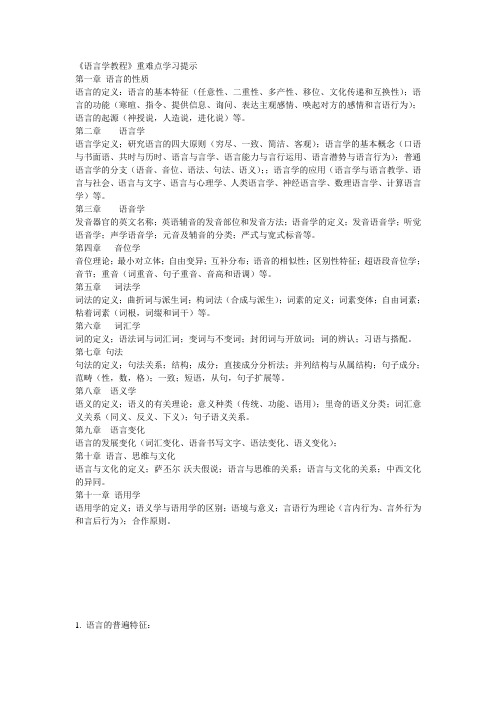
《语言学教程》重难点学习提示第一章语言的性质语言的定义:语言的基本特征(任意性、二重性、多产性、移位、文化传递和互换性);语言的功能(寒暄、指令、提供信息、询问、表达主观感情、唤起对方的感情和言语行为);语言的起源(神授说,人造说,进化说)等。
第二章语言学语言学定义;研究语言的四大原则(穷尽、一致、简洁、客观);语言学的基本概念(口语与书面语、共时与历时、语言与言学、语言能力与言行运用、语言潜势与语言行为);普通语言学的分支(语音、音位、语法、句法、语义);;语言学的应用(语言学与语言教学、语言与社会、语言与文字、语言与心理学、人类语言学、神经语言学、数理语言学、计算语言学)等。
第三章语音学发音器官的英文名称;英语辅音的发音部位和发音方法;语音学的定义;发音语音学;听觉语音学;声学语音学;元音及辅音的分类;严式与宽式标音等。
第四章音位学音位理论;最小对立体;自由变异;互补分布;语音的相似性;区别性特征;超语段音位学;音节;重音(词重音、句子重音、音高和语调)等。
第五章词法学词法的定义;曲折词与派生词;构词法(合成与派生);词素的定义;词素变体;自由词素;粘着词素(词根,词缀和词干)等。
第六章词汇学词的定义;语法词与词汇词;变词与不变词;封闭词与开放词;词的辨认;习语与搭配。
第七章句法句法的定义;句法关系;结构;成分;直接成分分析法;并列结构与从属结构;句子成分;范畴(性,数,格);一致;短语,从句,句子扩展等。
第八章语义学语义的定义;语义的有关理论;意义种类(传统、功能、语用);里奇的语义分类;词汇意义关系(同义、反义、下义);句子语义关系。
第九章语言变化语言的发展变化(词汇变化、语音书写文字、语法变化、语义变化);第十章语言、思维与文化语言与文化的定义;萨丕尔-沃夫假说;语言与思维的关系;语言与文化的关系;中西文化的异同。
第十一章语用学语用学的定义;语义学与语用学的区别;语境与意义;言语行为理论(言内行为、言外行为和言后行为);合作原则。
胡壮麟《语言学教程》笔记和考研真题及典型题详解(语 音)【圣才出品】
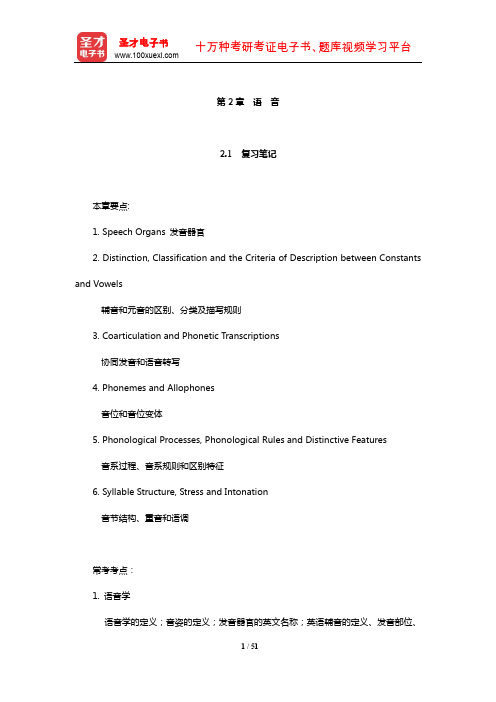
第2章语音2.1 复习笔记本章要点:1. Speech Organs 发音器官2. Distinction, Classification and the Criteria of Description between Constants and Vowels辅音和元音的区别、分类及描写规则3. Coarticulation and Phonetic Transcriptions协同发音和语音转写4. Phonemes and Allophones音位和音位变体5. Phonological Processes, Phonological Rules and Distinctive Features音系过程、音系规则和区别特征6. Syllable Structure, Stress and Intonation音节结构、重音和语调常考考点:1. 语音学语音学的定义;音姿的定义;发音器官的英文名称;英语辅音的定义、发音部位、发音方法和分类;英语元音的定义和分类、基本元音;发音语音学;听觉语音学;声学语音学;语音标记,国际音标;严式与宽式标音法。
2. 音系学音系学的定义;音系学与语音学的联系和区别;音素、音位、音位变体、最小对立体、自由变体的定义;音位理论;自由变异;音位的对立分布与互补分布;语音的相似性;区别性特征;超语段音位学;音节;重音(词重音、句子重音);音高和语调。
本章内容索引I. The Definition of Phonetics and Phonology1. Phonetics2. Three Major Research Fields of Phonetics3. PhonologyII. Speech Organs▼1. Gestures2. Speech organs3. Voiceless sounds4. Voiced sounds5. IPAIII. Consonants and Vowels1. Definition2. Consonants(1) Manner of Articulation and Place of Articulation(2) Classification of Consonants3. Vowel(1) Cardinal vowels(2) Criteria of vowel description(3) Monophthongs, Diphthongs and Triphthongs IV. Coarticulation and Phonetic Transcriptions*1. Coarticulation*2. Phonetic TranscriptionV. Phonemes and Allophones1. Phoneme2. AllophonesVI. Phonological Processes and Distinctive Features1. Phonological processes2. Assimilation*3. Distinctive featuresVII. Suprasegmentals1. Suprasegmental features2. The Syllable Structure▼3. Sonority Scale▼4. Stress(1) Change of the stresses due to suffixes(2) Stresses in compounds and phrases5. Intonation and ToneI. The Definition of Phonetics and Phonology (语音学和音系学的定义)1. Phonetics (语音学)Phonetics studies how speech sounds are produced, transmitted, and perceived.语音学研究语音的发生、传递和感知。
胡壮麟《语言学教程》笔记和考研真题详解(语言与认知)【圣才出品】

胡壮麟《语⾔学教程》笔记和考研真题详解(语⾔与认知)【圣才出品】第6章语⾔与认知6.1 复习笔记本章要点:1. Psycholinguistics⼼理语⾔学2. Language acquisition, language comprehension, language production 语⾔习得,语⾔的理解,语⾔的⽣成3. First language acquisition第⼀语⾔习得4. Cognitive linguistics认知语⾔学常考考点:语⾔习得;第⼀语⾔习得;语⾔的理解和⽣成;范畴;隐喻;整合理论等。
本章内容索引:I. Definition of cognitionII. Definition of PsycholinguisticsIII. Language acquisition1. The Behaviorist Approach2. The Innateness HypothesisIV. Language comprehension1. Sound Comprehension2. Word recognition3. Comprehension of sentences4. Comprehension of textV. Language Production1. Access to words2. Generation of sentences3. Written language productionVI. Cognitive Linguistics1. Definition2. Construal and Construal Operations(1) Attention/ Salience(2) Judgment/ Comparison(3) Perspective/ Situatedness3. Categorization(1) Basic level(2) Superordinate level(3) Subordinate level4. Image Schemas5. Metaphor(1) Ontological metaphors(2) Structural metaphors(3) Orientional metaphors6. Metonymy7. Blending TheoryI. Definition of cognition (认知的定义)Cognition is used in several different loosely related disciplines. In psychology it is used to refer to the mental processes of an individual, with particular relation to a concept which argues that the mind has internal mental states (such as beliefs, desires and intentions) and can be understood as information processing, especially when much abstraction or concretization is involved, or processes such as involving knowledge, expertise or learning for example are at work. Another definition of “cognition” is the mental process or faculty of knowing, including aspects such as awareness, perception, reasoning, and judgment.“认知”⼀词既可⽤于不同学科也可⽤于相关学科。
胡壮麟《语言学教程》章节题库(现代语言学理论与流派)【圣才出品】

第12章现代语言学理论与流派Ⅰ. Fill in the blanks.1. The structural approach to the analysis of language was started by the Swiss linguist _____ in the beginning of the twentieth century.【答案】Saussure【解析】对语言的结构性分析方法是在20世纪初,由瑞士语言学家索绪尔开启的,他被称为“现代语言学之父”和一位“使语言学走向现代的大师”。
2. Functional Sentence Perspective (FSP) is a theory of linguistic analysis which describes how _____ is distributed in sentences.【答案】information【解析】功能句子观是一套语言学分析理论,它是指用信息论的原理来分析话语或文本。
3. Systemic-Functional Grammar, unlike traditional grammar which takes sentence as the largest unit, takes _____ as the basic unit.【答案】clause【解析】与传统语法不同,系统功能语法把句子作为最大单位,把分句作为最小单位。
4. In Halliday’s Systemic Grammar, a system is a list of things between which it is possible to choose. So they are meanings, which the grammar can distinguish.The items in a system are called _____.【答案】options【解析】系统就是存在于语法中的一系列选择。
胡壮麟《语言学教程》笔记和考研真题及典型题详解(语言的使用)【圣才出品】
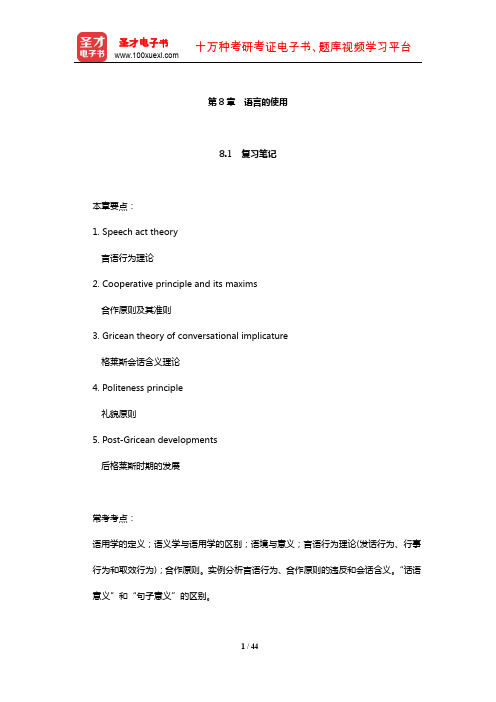
第8章语言的使用8.1 复习笔记本章要点:1. Speech act theory言语行为理论2. Cooperative principle and its maxims合作原则及其准则3. Gricean theory of conversational implicature格莱斯会话含义理论4. Politeness principle礼貌原则5. Post-Gricean developments后格莱斯时期的发展常考考点:语用学的定义;语义学与语用学的区别;语境与意义;言语行为理论(发话行为、行事行为和取效行为);合作原则。
实例分析言语行为、合作原则的违反和会话含义。
“话语意义”和“句子意义”的区别。
本章内容索引:I. Pragmatics1. Definition2. Difference between pragmatics and semantics II. Speech Act Theory1. Performatives and Constatives(1) Definition(2) Felicity Conditions2. A Theory of the Illocutionary Act3. Searle’s Classification of Speech Acts(1) Representatives:(2) Directives(3) Commsives(4) Expressives(5) DeclarationsIII. Cooperative Principle (CP)1. Cooperative Principle and Its Maxims2. Violation of the MaximsIV. Conversational Implicature1. Definition2. Characteristics of Conversational Implicature(1) Calculability.(2) Cancellability(3) Non-detachability(4) Non-conventionality.V. Politeness Principle (PP)VI. Post-Gricean Developments1. Relevance Theory2. The Q- and R-principles3. Levinson’s Q-, I-and M-principles▼4. A socio-cognitive approachI. Pragmatics (语用学)【考点:Pragmatics与Semantics的异同】1. Definition (定义)Pragmatics is the study of language in use, focusing on the study of speaker’s meaning, utterance meaning or contextual meaning.语用学是研究语言实际运用的学科,集中研究说话人意义、话语意义或语境意义。
胡壮麟《语言学教程》笔记和考研真题及典型题详解(7-12章)【圣才出品】

1 / 147
圣才电子书 十万种考研考证电子书、题库视频学习平台
different languages may probably express their unique ways of understanding the world. Following his argument, two important points could be captured in this theory. On the one hand, language may determine our thinking patterns; on the other, similarity between languages is relative. For two different speech communities, the greater their structural differentiations are, the more diverse their conceptualization of the world will be. For this reason, this hypothesis has alternatively been referred to as linguistic determinism and linguistic relativity. 【考点:名词解释;指出该假说的两种版本】
②To help the students transcend their own culture and see things as the members of the
(完整word版)胡壮麟语言学教程笔记、重点
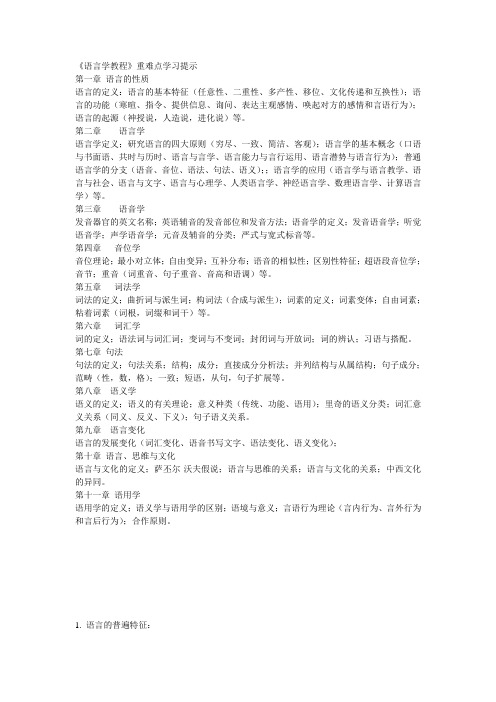
《语言学教程》重难点学习提示第一章语言的性质语言的定义:语言的基本特征(任意性、二重性、多产性、移位、文化传递和互换性);语言的功能(寒暄、指令、提供信息、询问、表达主观感情、唤起对方的感情和言语行为);语言的起源(神授说,人造说,进化说)等。
第二章语言学语言学定义;研究语言的四大原则(穷尽、一致、简洁、客观);语言学的基本概念(口语与书面语、共时与历时、语言与言学、语言能力与言行运用、语言潜势与语言行为);普通语言学的分支(语音、音位、语法、句法、语义);;语言学的应用(语言学与语言教学、语言与社会、语言与文字、语言与心理学、人类语言学、神经语言学、数理语言学、计算语言学)等。
第三章语音学发音器官的英文名称;英语辅音的发音部位和发音方法;语音学的定义;发音语音学;听觉语音学;声学语音学;元音及辅音的分类;严式与宽式标音等。
第四章音位学音位理论;最小对立体;自由变异;互补分布;语音的相似性;区别性特征;超语段音位学;音节;重音(词重音、句子重音、音高和语调)等。
第五章词法学词法的定义;曲折词与派生词;构词法(合成与派生);词素的定义;词素变体;自由词素;粘着词素(词根,词缀和词干)等。
第六章词汇学词的定义;语法词与词汇词;变词与不变词;封闭词与开放词;词的辨认;习语与搭配。
第七章句法句法的定义;句法关系;结构;成分;直接成分分析法;并列结构与从属结构;句子成分;范畴(性,数,格);一致;短语,从句,句子扩展等。
第八章语义学语义的定义;语义的有关理论;意义种类(传统、功能、语用);里奇的语义分类;词汇意义关系(同义、反义、下义);句子语义关系。
第九章语言变化语言的发展变化(词汇变化、语音书写文字、语法变化、语义变化);第十章语言、思维与文化语言与文化的定义;萨丕尔-沃夫假说;语言与思维的关系;语言与文化的关系;中西文化的异同。
第十一章语用学语用学的定义;语义学与语用学的区别;语境与意义;言语行为理论(言内行为、言外行为和言后行为);合作原则。
胡壮麟《语言学教程》笔记和考研真题及典型题详解(词和形态学)【圣才出品】
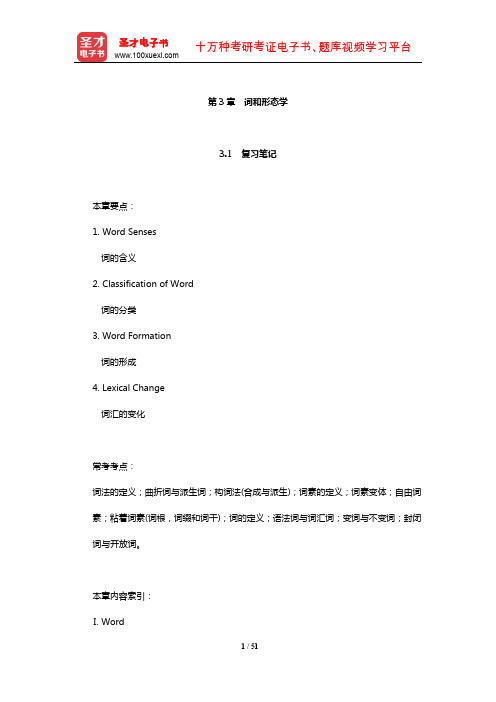
1. Three Senses of “Word” (词的三种含义) (1) a physically definable unit; (2) both a general and specific term; (3) a grammatical unit. (1) 词是自然的有界限的对立单位; (2) 词既是一个普通术语又是一个与门术语; (3) 词是一个语法单位。
圣才电子书 十万种考研考证电子书、题库视频学习平台
第 3 章 词和形态学
3.1 复习笔记
本章要点: 1. Word Senses
词的含义 2. Classification of Word
词的分类 3. Word Formation
词的形成 4. Lexical Change
4 / 51
圣才电子书 十万种考研考证电子书、题库视频学习平台
Word is the smallest unit that can be used, by itself, as a complete utterance. (1) 就词的内部结构而言,词是所有语言单位中最稳定的。 (2) 连续性指的是一个词的几个成分之间丌可介入新的成分,即使这个词由多个成分构成。 (3) 词是能够独立构成一个完整语句的最小单位。
胡壮麟《语言学教程》笔记和考研真题详解(语言与文学)【圣才出品】
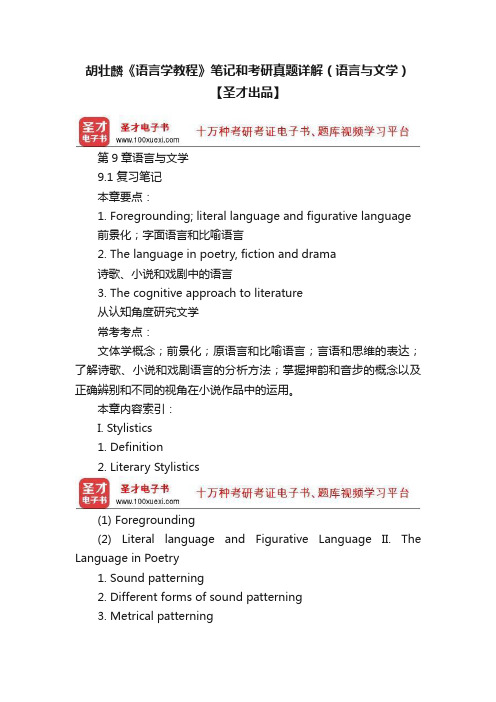
胡壮麟《语言学教程》笔记和考研真题详解(语言与文学)【圣才出品】第9章语言与文学9.1 复习笔记本章要点:1. Foregrounding; literal language and figurative language前景化;字面语言和比喻语言2. The language in poetry, fiction and drama诗歌、小说和戏剧中的语言3. The cognitive approach to literature从认知角度研究文学常考考点:文体学概念;前景化;原语言和比喻语言;言语和思维的表达;了解诗歌、小说和戏剧语言的分析方法;掌握押韵和音步的概念以及正确辨别和不同的视角在小说作品中的运用。
本章内容索引:I. Stylistics1. Definition2. Literary Stylistics(1) Foregrounding(2) Literal language and Figurative Language II. The Language in Poetry1. Sound patterning2. Different forms of sound patterning3. Metrical patterning4. Conventional forms of meter and sound5. The poetic functions of sound and meter6. How to analyze poetryIII. The Language in Fiction1. Fiction prose and points of view(1) I-narrators(2) Third-person narrators(3) Schema-oriented language(4) Given vs. New information(5) Deixis2. Speech and thought presentation(1) Speech presentation(2) Thought presentation(3) Stream of consciousness writing3. Prose style(1) Authorial style(2) Text style4. How to analyze the language of fictionIV. The Language in Drama1. How to analyze drama2. Analyzing dramatic languageV. The Cognitive Approach to Literature1. Figure and Ground2. Image Schemata3. Cognitive MetaphorI. Stylistics (文体学)1. Definition (定义)It is a branch of linguistics studies the features of situationallydistinctive uses (varieties) of language, and tries to establish principles capable of accounting for the particular choices made by individual and social groups in their use of language.文体学作为语言学的分支,主要研究特殊语境中语言的特征(即语言的多样性),并试图建立一些规则,以解释个体和社团在语言使用过程中的特殊选择。
胡壮麟《语言学教程》(第5版)笔记和考研真题详解
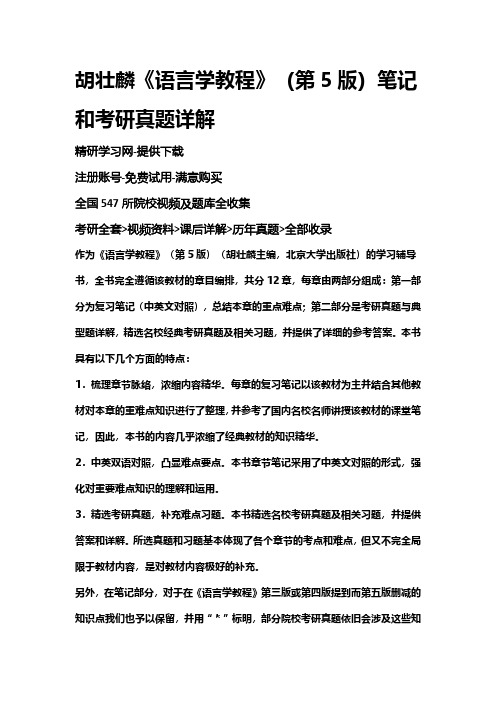
胡壮麟《语言学教程》(第5版)笔记和考研真题详解精研学习网-提供下载注册账号-免费试用-满意购买全国547所院校视频及题库全收集考研全套>视频资料>课后详解>历年真题>全部收录作为《语言学教程》(第5版)(胡壮麟主编,北京大学出版社)的学习辅导书,全书完全遵循该教材的章目编排,共分12章,每章由两部分组成:第一部分为复习笔记(中英文对照),总结本章的重点难点;第二部分是考研真题与典型题详解,精选名校经典考研真题及相关习题,并提供了详细的参考答案。
本书具有以下几个方面的特点:1.梳理章节脉络,浓缩内容精华。
每章的复习笔记以该教材为主并结合其他教材对本章的重难点知识进行了整理,并参考了国内名校名师讲授该教材的课堂笔记,因此,本书的内容几乎浓缩了经典教材的知识精华。
2.中英双语对照,凸显难点要点。
本书章节笔记采用了中英文对照的形式,强化对重要难点知识的理解和运用。
3.精选考研真题,补充难点习题。
本书精选名校考研真题及相关习题,并提供答案和详解。
所选真题和习题基本体现了各个章节的考点和难点,但又不完全局限于教材内容,是对教材内容极好的补充。
另外,在笔记部分,对于在《语言学教程》第三版或第四版提到而第五版删减的知识点我们也予以保留,并用“*”标明,部分院校考研真题依旧会涉及这些知识点的考查。
相对于第三版或第四版,对于在第五版新增加的知识点用“▼”标明,以便于使用不同版本教材的读者使用。
第1章语言学导论1.1复习笔记1.2考研真题与典型题详解第2章语音2.1复习笔记2.2考研真题与典型题详解第3章词和形态学3.1复习笔记3.2考研真题与典型题详解第4章句法:从语词到篇章4.1复习笔记4.2考研真题与典型题详解第5章意义5.1复习笔记5.2考研真题与典型题详解第6章语言与认知6.1复习笔记6.2考研真题与典型题详解第7章语言文化社会7.1复习笔记7.2考研真题与典型题详解第8章语言的使用8.1复习笔记8.2考研真题与典型题详解第9章语言与文学9.1复习笔记9.2考研真题与典型题详解第10章语言和计算机10.1复习笔记10.2考研真题与典型题详解第11章第二语言和外语教学11.1复习笔记11.2考研真题与典型题详解第12章现代语言学理论与流派12.1复习笔记12.2考研真题与典型题详解。
- 1、下载文档前请自行甄别文档内容的完整性,平台不提供额外的编辑、内容补充、找答案等附加服务。
- 2、"仅部分预览"的文档,不可在线预览部分如存在完整性等问题,可反馈申请退款(可完整预览的文档不适用该条件!)。
- 3、如文档侵犯您的权益,请联系客服反馈,我们会尽快为您处理(人工客服工作时间:9:00-18:30)。
第12章现代语言学理论与流派12.1 复习笔记本章要点:1. The Prague School and Functional Sentence Perspective (FSP)布拉格学派与功能句子观2. The London School and context of situation伦敦学派与语境观3. Halliday and Systemic-Functional Grammar韩礼德与系统——功能语法4. Bloomfield and American Structuralism布隆菲尔德与美国结构主义5. Chomsky and Transformational-Generative Grammar乔姆斯基与转换——生成语法常考考点:各流派的代表人物、理论基础、特点、主要观点、重要概念;语言普遍性和人类行为关系等。
本章内容索引:I. Saussure and modern linguisticsII. The Prague School1. Main points and contribution2. Functional Sentence Perspective (FSP)3. Communicative Dynamism (CD)III. The London School1. Introduction2. Malinowski’s theories3. Firth’s theories4. Halliday and Systemic-Functional Grammar5. Systemic grammar and Functional grammar(1) Systemic grammar(2) Functional grammarIV. American Structuralism1. Introduction2. Three stages of the developmentV. Transformational-Generative Grammar1. Introduction2. The Innateness Hypothesis3. Generative Grammar4. Stage of development of TG Grammar5. Main features of TG GrammarI. Saussure and modern linguistics (索绪尔和现代语言学)Modern linguistics has started from the Swiss linguist Ferdinand de Saussure (1857-1913) , who is often described as “father of modern linguistics” and “a master of a discipline which he made modern”.According to Saussure, language is a system of signs which uses sounds to express and exchange ideas. The sign is the union of a form and an idea, i.e. the signifier and the signified. The sign is the central fact of language, and therefore the study of language must start from the nature of the sign itself.Saussure identifies several groups of important concepts: signifier and signified, langue and parole, synchronic and diachronic research, etc.现代语言学始于瑞士语言学家索绪尔,他被称为“现代语言学之父”和一位“使语言学走向现代的大师”。
索绪尔认为,语言是用声音表达交流思想的符号系统。
符号是形式和意义的联合,是表示者和被表示者的结合。
符号是语言事实的核心,研究语言必须从符号本身的特性入手。
索绪尔区分了几组重要的概念:能指和所指,语言和言语,共时研究和历时研究等。
II. The Prague School (布拉格学派)【考点:简答——布拉格学派的主要观点及代表人物】The Prague School can be traced back to its first meeting under the leadership of V. Mathesius.布拉格学派的形成可以追溯到马泰休斯领导召开的该学派的第一次会议。
1. Main points and contribution (主要观点及贡献)The Prague School has three points of special importance:(1) It stresses that the synchronic study of language is fully justified as it can draw on complete and controllable material for investigation.(2) It emphasizes the systemic character of language, arguing that no element of any language can be satisfactory analyzed or evaluated if viewed in isolation. In other words, elements are held to be in functional contrast or opposition.(3) It looks on language as a tool performing a number of essential functions or tasks for the community using it.布拉格学派的研究有三大重点:(1)强调共时研究的合理性,因为它可以提供完整且易掌控的研究材料。
(2)强调语言的系统性,指出任何语言单位都不能在孤立的的情况下得到令人满意的分析及评估。
换句话说,语言单位处于功能对比、对立之中。
(3)它将语言看作是在所属语言群体中发挥一系列功能的工具。
2. Functional Sentence Perspective (FSP) (功能句子观)Functional Sentence Perspective (FSP) is a theory of linguistic analysis which refers to an analysis of utterances (or texts) in terms of the information they contain. The principle is that the role of each utterance is evaluated for its semantic contribution to the whole.Some Czech linguists devoted considerable attention to problems of analyzingsentences from a functional point of view. They argue that a sentence contains a point of departure and a goal of discourse. The point of departure is equally present to the speaker and to the hearer—it is the ground on which they meet and is regarded as the theme. The goal of discourse presents the very information that is to be imparted to the hearer, and is called the rheme. The movement from the theme to the rheme reveals the movement of the mind itself.【考点:指出给定句子的主位和述位】FSP deals particularly with the effect of the distribution of known (or given) information and new information in discourse. The known information refers to information that is not new to the reader or hearer. The new information is what needs to be transmitted to the reader or hearer. The Subject-Predicate distinction is not always the same as the Theme-Rheme contrast功能句子观是一套语言学分析理论,它是指用所含信息来分析话语或文本。
其基本原则就是一句话中各部分起的作用取决于它对全句意义的贡献。
一些捷克语言学家尝试从功能的角度来分析句子。
他们相信一个句子包含话语的出发点和话语的目的。
话语的出发点叫做主位,它是说话人和听话人都知道的信息;话语的目的是说话人要向听话人传递的信息,叫做述位。
从主位到述位的运动揭示了大脑本身的运动。
功能句子观旨在研究话语中新(未知)、旧(已知)信息的分布问题。
已知信息指那些对于听话人不再是新信息的部分;新信息是即将向听话人传达的信息。
句子中主语-谓语的分布不总是与主位-述位的分布一致。
3. Communicative Dynamism (CD) (交际能力)CD is another version of the same analysis, which was proposed by Firbas. By CD, Firbas means the extent to which the sentence elements contribute to the development of the communication.Firbas defined FSP as the distribution of different degrees of CD. In his view, the initial elements of a sequence carry the lowest degree of CD and with each step forward, the degree of CD becomes incremental till the element that carries the highest.另一种版本的分析法叫做交际能力,由费尔巴斯提出。
